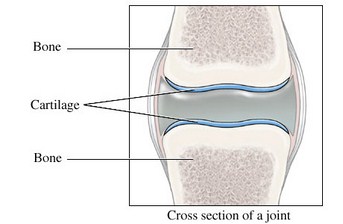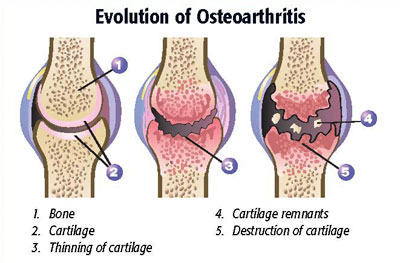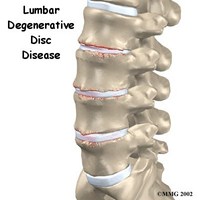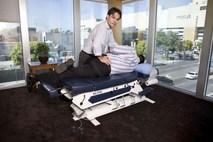Arthritis Pain Relief: Degenerative Joint Disease Doesn’t Have to Cripple You
by Dr. Nicolas Campos
 Question: What affects 27 million people and is the leading cause of disability in the U.S? OK, OK, you saw it in the title…that’s right, arthritis! Osteoarthritis (OA) or degenerative joint disease (DJD) is a painful condition of joint inflammation, diminished movement and eventually joint breakdown. It should sound fairly similar to an entity I speak of regularly in these articles, the vertebral subluxation, and that’s because the two are intimately connected. In fact, as you read you will see that arthritis shares many components with the subluxation complex. As a result, treating the two is pretty much the same, making chiropractic a great natural choice for arthritis pain relief. Question: What affects 27 million people and is the leading cause of disability in the U.S? OK, OK, you saw it in the title…that’s right, arthritis! Osteoarthritis (OA) or degenerative joint disease (DJD) is a painful condition of joint inflammation, diminished movement and eventually joint breakdown. It should sound fairly similar to an entity I speak of regularly in these articles, the vertebral subluxation, and that’s because the two are intimately connected. In fact, as you read you will see that arthritis shares many components with the subluxation complex. As a result, treating the two is pretty much the same, making chiropractic a great natural choice for arthritis pain relief.
Before we begin, I would like to point out that there are several different types of arthritis, as this term covers anything which describes joint inflammation (“itis” means inflammation). I will, however, only be discussing osteoarthritis, meaning “bone-joint-inflammation,” as opposed to autoimmune disorders like rheumatoid arthritisand systemic lupus erythematosus (SLE), or metabolic disorders like gout,amyloidosis and hyperlipidemia. What is Degenerative Joint Disease (DJD)?Osteoarthritis or DJD is an inflammatory condition of the joint that causes pain, swelling and lack of movement. It can affect any joint, big or small, and if left untreated, can lead to complete breakdown and eventually fusion of the joint.
Inflammation is caused by the degeneration, or wearing-away, of cartilage in the joint itself. Being the main moving parts of the musculoskeletal system, the hinges if you will, joints have cartilage sitting on each bone end. Consider cartilage a smooth surface that decreases friction, almost like a polished metal or even linoleum plate. To think of how much each joint of the human body moves throughout a lifetime, it is amazing to consider the durability joints actually have. Saying that, joint surfaces can wear down—the cartilage breaks down, little by little, until the plate gets worn to the bone (think of a worn down pencil eraser for lack of a better analogy). When this happens, the pain that accompanies movement of that particular joint can be excruciating.
Degeneration is a time process, and along the way inflammation sets in, with its cardinal signs of heat, redness, swelling, pain, and loss of function. Let me emphasize one point: LOTS OF PAIN! I always say, “Want to see a grown man cry? Observe a man with arthritis in his neck.” Really, it’s tough to witness.
Who Gets Degenerative Joint Disease (DJD)?
The fact is that everybody degenerates to some degree or another. The degenerative process begins in our twenties and continues throughout our lifetime, so it is how fast we degenerate that really matters. What this means is that the rate of degeneration is really more important than whether we will degenerate or not, because this is what ultimately determines how much pain and disability a person will suffer.
Since we all degenerate, what determines whether you will be one of the 27 million people afflicted with arthritis or not? Simple…it comes down to lifestyle (there I go again). Degeneration and arthritis can happen at any joint—common areas are the low back (or lumbar spine), the neck (or cervical spine), the hips (sacroiliac and femoral acetabular joints), the knees and the hands. You could have joint inflammation for years before complete degeneration (down to the bone) actually occurs. What Causes Degenerative Joint Disease (DJD)?
It is not uncommon in my Los Angeles, Beverly Hills and West Hollywood chiropractic clinic to see arthritis in people that have been in auto accidents sometimes five, ten or even twenty years ago, with varying stages of advanced spinal degeneration. Degeneration of the lumbar spine leads to low back pain, and it can be a consequence of wearing seat belts. Although these amazing life-savers have done wonders in decreasing auto accident deaths, the number of low back injuries has skyrocketed as a result. Why? Consider what happens when the body accelerates from an impact, just to be stopped suddenly and violently when the seat belt locks shut. The shearing forces a joint must absorb in these acceleration-deceleration accidents can be incredible—and this can drastically increase the rate of degeneration.
Over time, excessive loading from obesity will catch up to a joint, and you can throw in the hips, sacroiliac and knee joints to boot—each one of these joints is commonly worn down in obese people. Finally, and most important, is that chronic lack of movement can lead to DJD. People that neglect movement, whether they are mostly sedentary (couch potatoes, the elderly, obese) or they just don’t exercise much, are at a greater risk of developing DJD. This is because joints are meant to move. It is through movement that joints self-lubricate, coating the cartilage surface with a viscous liquid film of synovium. Synovial fluid decreases friction lessening wear and tear, in the same way motor oil does in an engine. When movement is lacking, there is little to no lubrication of the joint, and thus, no protection.
An all too common form of non-movement affecting the joint in a similar but perhaps even worse way than being sedentary is the subluxation. Subluxations, you’ll remember from my earlier articles, is a non-moving joint. Recall that joint surfaces can stick together preventing lubrication and locking-up the joint itself. Both non-lubrication and non-movement together are disastrous for the joint cartilage. This is when the body will start an auto-breakdown of the joint in an attempt to form a non-moving structure. Although it may seem unintelligent for the body to create a non-moving structure out of an existing moving part, deeper thought unveils that the body doesn’t know the difference between conscious and unconscious inactivity—it only knows that moving parts are meant to move, period! When this doesn’t happen freely and regularly, why would the body exert energy and raw materials to maintain it as a moving part? How to Treat Degenerative Joint Disease (DJD)Treating DJD and osteoarthritis may not be as difficult as we’ve been told for so many decades. Traditionally, this debilitating condition has been addressed medically with drugs—anti-inflammatories and pain killers—instructions to limit movements (is this wise?), and sometimes even surgeries (hip and knee replacements, and such). Without a doubt, some hips and knees get arthritis bad enough to need mechanical replacing, but DJD/arthritis of the back and neck can be treated conservatively.
Whether we are talking arthritis of the knee, hip or low back, a chiropractic adjustment can reduce the pain associated with DJD and arthritis effectively. Once normal motion resumes, there is no reason why the person once suffering from osteoarthritis cannot resume a normal lifestyle. I have treated hundreds of people in my Los Angeles, Beverly Hills and West Hollywood chiropractic clinic that have had DJD. Without fail, every one of them has gotten dramatic relief with just a few adjustments. Just think what that does for a person who thinks he or she would have to live in pain and disability for the rest of their lives. My own mother had severe degeneration and arthritis of her neck, and with a short round of chiropractic care she wa s moving and dancing and playing with her grandchildren, and doing everything a normal person does simply because we returned the proper movement to her neck joints. Many of my clients throw their pain killers and anti-inflammatories away because getting regular chiropractic care is enough to keep them arthritis pain free for years. How to Prevent Degenerative Joint Disease (DJD)OK but what if you don’t have symptoms of arthritis or DJD, is there anything you can do to prevent it from happening in the first place? You bet there is—you just have to counter the usual causes of DJD.
Next you need to move—regularly. That means exercise, two to three times per week. It doesn’t mean you have to go pounding the weights necessarily (which can, believe it or not, increase your rate of degeneration, particularly if you don’t stretch), just find some physical activity you love to do, whether walking, hiking or dancing; just make sure it’s done regularly.
Next is keeping the weight down—I know, we all know this. Great, then why aren’t you doing it? Listen, I understand the struggles involved, and I sympathize, but the bottom line is that excess weight breaks down joints rapidly. No one is saying to “get skinny,” just reduce what weight you can. Even if you aren’t losing weight as fast as you’d like, you should still get chiropractic care and move as much as possible. *Walking is a great low impact exercise for overweight people. If you take on this regimen—regular chiropractic, movement and reducing weight—I guarantee you can beat the pain associated with arthritis. If you make this a part of your regular lifestyle, you can probably remain relatively pain free for years, if not forever. Further, by adopting these three lifestyle habits, you can prevent osteoarthritis or DJD from ever being a painful experience for you. Take it from a Los Angeles chiropractor that has treated hundreds of arthritis pain patients—DJD of the low back or neck is effectively treated with powerful chiropractic care. Why suffer any longer? Call a chiropractor today!March 21, 2011 |




 Although the incidence of osteoarthritis increases as people age, it is NOT a condition of aging. What I mean by this is that there are documented cases of ninety-year-olds that exhibit no signs of arthritis. So linking it to normal aging is a fallacy.
Although the incidence of osteoarthritis increases as people age, it is NOT a condition of aging. What I mean by this is that there are documented cases of ninety-year-olds that exhibit no signs of arthritis. So linking it to normal aging is a fallacy. Some people degenerate faster than others—some because of genetics, some from trauma, and others from repeatedly carrying heavy loads. Whatever the cause of existing degeneration in any given person, let it be understood that the pain and disability which comes from osteoarthritis can be beaten—it can be relieved. And further degeneration can be prevented too, if the proper steps are taken, and a new lifestyle is adopted (sorry, but I had to).
Some people degenerate faster than others—some because of genetics, some from trauma, and others from repeatedly carrying heavy loads. Whatever the cause of existing degeneration in any given person, let it be understood that the pain and disability which comes from osteoarthritis can be beaten—it can be relieved. And further degeneration can be prevented too, if the proper steps are taken, and a new lifestyle is adopted (sorry, but I had to). There are several causes of DJD and accompanying arthritis. For one, trauma can increase the rate of degeneration, so can
There are several causes of DJD and accompanying arthritis. For one, trauma can increase the rate of degeneration, so can  Another cause of DJD is obesity, and this is especially true of arthritis in the lumbar spine. Think about the loads a joint in the low back must carry when a person is more than a little overweight. The lumbar spine, particularly the fifth lumbar vertebra (L5), is a massive weight bearing joint—the biggest, in fact. When you realize how much load it needs to handle on a daily basis in normal weight individuals, then it shouldn’t be too hard to imagine what goes on when the body weight triples, quadruples or goes even beyond these massive loads.
Another cause of DJD is obesity, and this is especially true of arthritis in the lumbar spine. Think about the loads a joint in the low back must carry when a person is more than a little overweight. The lumbar spine, particularly the fifth lumbar vertebra (L5), is a massive weight bearing joint—the biggest, in fact. When you realize how much load it needs to handle on a daily basis in normal weight individuals, then it shouldn’t be too hard to imagine what goes on when the body weight triples, quadruples or goes even beyond these massive loads.

 First and foremost, getting regular chiropractic care is essential. Plain and simple, your joints need to move—all of them. If you are having subluxations (if you don’t know, please visit your local chiropractor), they must be adjusted. If you are not having any pain, then I suggest getting regular chiropractic checkups about once a month anyway, as a preventative. You can certainly go more often if you lead a very active lifestyle, but otherwise, a monthly chiropractic checkup will do you righteous. Think of it in the same way you think of regular dental care—easier to prevent spinal degeneration (cavities) than treat it (and you can’t get spinal dentures!)
First and foremost, getting regular chiropractic care is essential. Plain and simple, your joints need to move—all of them. If you are having subluxations (if you don’t know, please visit your local chiropractor), they must be adjusted. If you are not having any pain, then I suggest getting regular chiropractic checkups about once a month anyway, as a preventative. You can certainly go more often if you lead a very active lifestyle, but otherwise, a monthly chiropractic checkup will do you righteous. Think of it in the same way you think of regular dental care—easier to prevent spinal degeneration (cavities) than treat it (and you can’t get spinal dentures!) You will also want to stretch regularly. Tight muscles lead to compressed joints, which in turn leads to…you got it, wear and tear…breakdown…degeneration. Stretching a little every day is ideal. Can’t do it every day, then two to three times a week will still do wonders. Try it, you’ll see.
You will also want to stretch regularly. Tight muscles lead to compressed joints, which in turn leads to…you got it, wear and tear…breakdown…degeneration. Stretching a little every day is ideal. Can’t do it every day, then two to three times a week will still do wonders. Try it, you’ll see.